
Seasickness is a valid concern whether you’re a seasoned or first-time cruiser. I know some people who never step on a cruise ship for fear of motion sickness.
Motion sickness is unpredictable; it hits some passengers hard but doesn’t affect others. You can blame your parents because, in some cases, it’s hereditary.
Many can relate to your concerns if you have been one of those passengers who has suffered. Read on to find out how to prevent sea sickness on a cruise.
While decades ago, seasickness was a significant concern. Engineers design new cruise ships with the latest technology that minimizes movement.
An onboard computer system can adjust the gyroscopic stabilizers according to the waves and weather. Consequently, the result is a smoother sail in rough seas.
While I don’t suffer from seasickness, I have known others to suffer even on calm seas.
Understanding Seasickness
Seasickness or motion sickness is a common disturbance of the inner ear. It occurs when the central nervous system receives conflicting messages from the ears, eyes, and muscles.
One person can experience motion sickness on a boat, while another might suffer in a motor vehicle. Signs of motion sickness include nausea, vomiting, dizziness, drowsiness, sweating, and pale skin.
While the symptoms are only temporary, they can be miserable enough to ruin your vacation. So now that you understand it, how do you prevent seasickness?
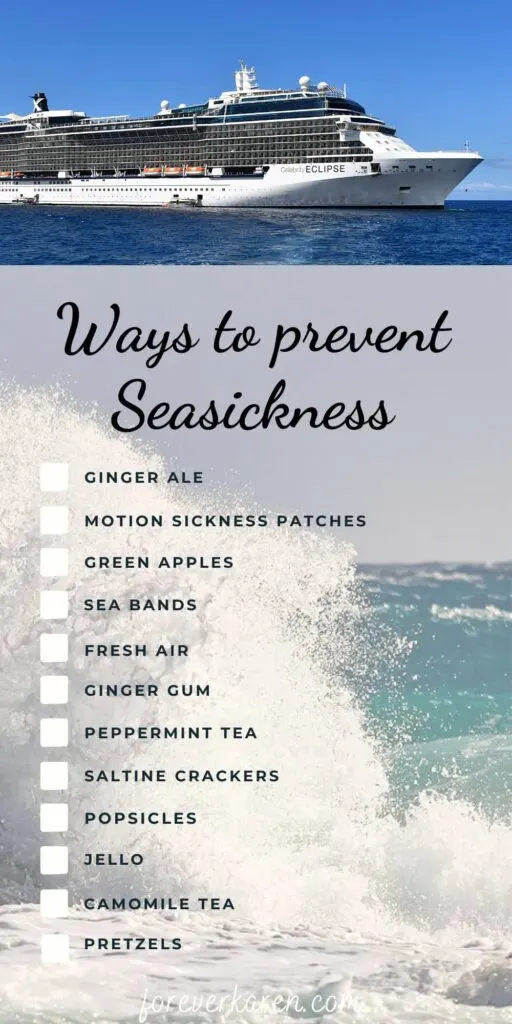
Cabin Location Can Prevent Seasickness
Cabin location plays a significant factor in minimizing motion. Picture an old fashion seesaw or teeter-totter. You feel the most movement sitting on the ends but less sitting in the middle.
When selecting your cruise ship location, choose a cabin on the lower decks close to the water line and mid-ship. Avoid a bow (front) or aft stateroom (back) where the most movement will occur.
This location experiences the least amount of movement in rough seas. Sometimes, focusing your eyes on a distant object like the horizon is helpful.
In this case, an outside cabin will be most beneficial. If sleeping in the dark minimizes your symptoms, an inside cabin may be preferable.
Will I Have Seasickness for the Whole Cruise?
The short answer is very unlikely. Once you get your sea legs, your body has adjusted to the new movement.
You will tend to feel seasickness (if you feel it) during your first sea day or rough seas. We have rarely been seasick during our many cruises; if we did, it was very brief.
If you are a first-time cruiser and want to be extra cautious, consider trying a seasickness patch BEFORE you get on the ship. Alternatively, wait until your first time feeling seasick and then try one of the remedies mentioned in this article.
Recently, we took my 81-year-old Mum on her first cruise. We sailed the Mexican Riviera out of Los Angeles.
Mum felt she was going to get seasick because the last time she was on a boat she was seasick. That was on a ferry in England, and that was over 50 years ago! Old memories are not forgotten!
As a prevention, before Mum boarded the Majestic Princess, I had her put one of the seasickness prevention patches behind her ears.
The cruise was perfect and she never felt sick once. At the end of the cruise, Mum asked where we were cruising next?
How Many Cruisers Get Seasick?
Among all cruisers, seasickness is rare. An estimated maximum of 10-15% of cruisers experience it anytime during the cruise.
However, seasickness varies drastically according to the itinerary, weather, and other factors. Open ocean cruising can have more significant turbulence.
When cruising years ago to Alaska, the seas became very rough once we left the Inside Passage and the protection of Vancouver Island. It was so bad that I had to brace my arms against the walls as I walked down the hallway to my cabin.
I remember seeing the dining room almost empty at dinner and asking the waiter, “Where is everyone?” About half the passengers felt seasick and had to stay in their cabins!
Does Itinerary Increase My Chance of Getting Seasick?
Yes, where you are cruising matters. If you are concerned about getting seasick, avoid cruises with open seas.
One of the original and classic cruises is the Transatlantic Crossing from London to New York on Cunard. It’s on our Bucket List, but sailing from New York to London would have a greater chance of rough seas due to crossing the Atlantic Ocean.
In contrast, the chance of seasickness is much less if you are sailing the Mediterranean or the Caribbean. If you are new to cruising and afraid you might suffer from sea sickness, consider the calm waters of a Caribbean cruise as an ideal first cruise.
If you are cruising around South America and sailing through the Drake Passage, it is known for its rough seas.
Bed Configuration
There are two primary motions on a cruise ship; pitching and rolling. Pitching is the motion of up and down from bow to stern.
On the other hand, rolling is the side-to-side motion from port to starboard. Since the ship is longer than wide, you are less likely to feel pitching.
For some, the rolling motion is more likely to cause motion sickness. It’s best to position your bed in the same direction as the wave so the movement is head to toe rather than side to side.
Beds in cabins are movable, so if you want to move your bed, speak to your cabin steward, who will be happy to assist you.
Prevent Seasickness With Ginger
Fresh ginger and ginger pills have long been known to alleviate nausea, upset stomach and prevent seasickness. Ginger is inexpensive and comes in a variety of forms.
When buying ginger pills or capsules, make sure these are pure ginger and not mixed with other herbs. Other options for taking ginger are tea, candy, powder, gum, drinks (ginger ale), biscuits (ginger snaps), inhaler, and essential oil.
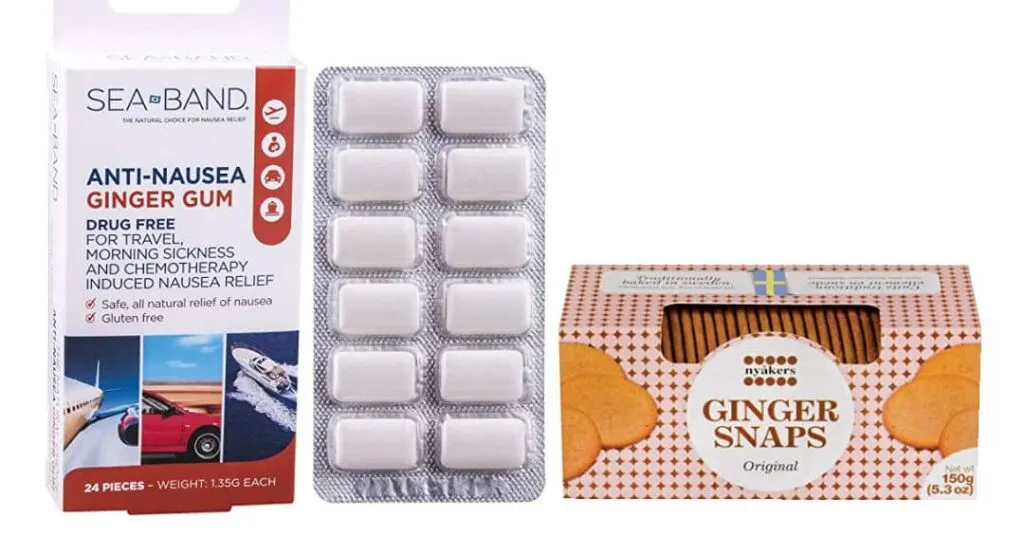
Some might find it comforting to suck on candied ginger, while others may prefer sipping ginger ale. Try the different varieties and find the best one that works for you.
Sea-Bands
Sea-Bands are comfortable elasticated wrist bands with a plastic stud. The bead applies pressure to the Nei Kuan acupressure point on each wrist.
As a result, the bands relieve motion sickness and vomiting. Sea bands are fast-acting, simple to use, and suitable for both adults and children.
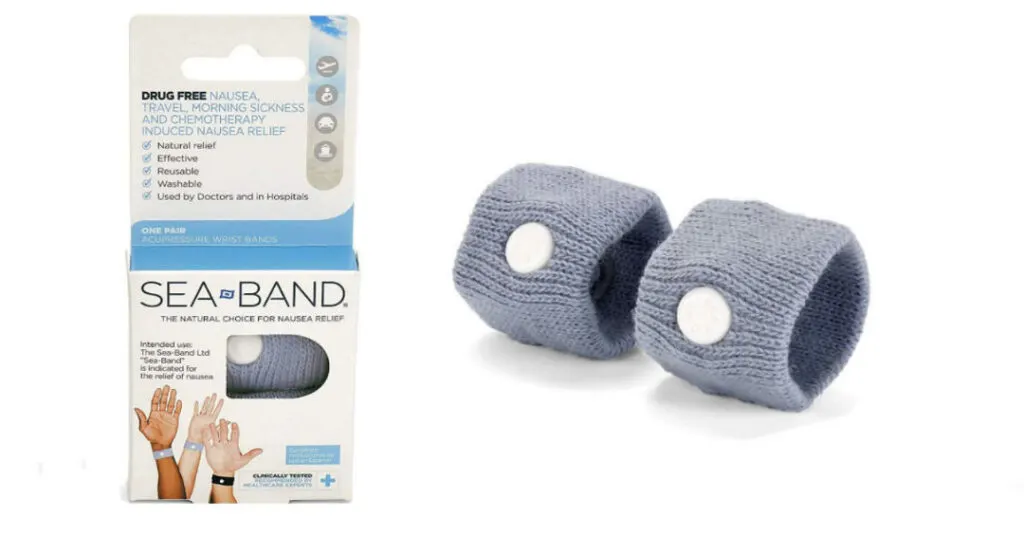
If you are pregnant, sea bands are the perfect option instead of using medication.
Motion Sickness Patches
Passengers on cruise ships widely use motion sickness patches. I have seen many passengers wear them, and I often stop to ask their opinion.
Those that I have spoken to swear by this product. I used them on a recent Alaska cruise during a rough sea day.
The patches were easy to use and quickly removed my queasy feeling. I liked that they were unnoticeable behind my ear.
To use the patch, remove the protective backing and stick the adhesive layer to the navel or the back of your ears. Apply 10 minutes before traveling; the patch can last from one to three days.
The patch is not waterproof, so a new one must be applied after a water activity.
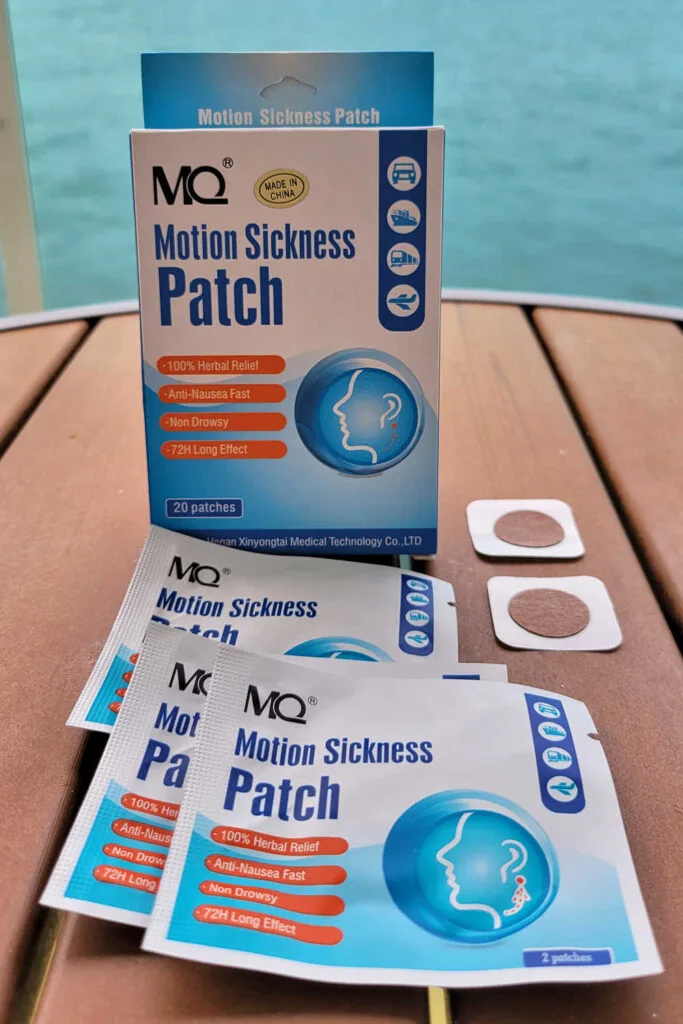
The one benefit of using a patch over the traditional Dramamine is that it doesn’t make you sleepy.
Dramamine
Gravol or Dramamine is an over-the-counter product medication used to treat nausea, vomiting, and motion sickness. It is available as tablets, liquid, and suppository.
While Dramamine works wonders for motion sickness, the major drawback is drowsiness. I found it very difficult to enjoy an excursion or cruise activity when feeling sedated.
If you’re in need of something to combat motion sickness, most cruise lines give out samples of medication at guest services or the medical facility. It’s one of the cruise freebies available on most cruises.
Fresh Air
While I generally don’t suffer from seasickness, riding in the back of a car is a different story. Even as a child, I remember getting ill, traveling through Europe during our family’s summer road trips.
I found it best to look forward and never to the side. And NEVER read anything because that made things worse.
Also, fresh air worked wonders, so I often had my car window open even when cold. Since fresh air can often help alleviate motion sickness, try to get plenty of it up on deck or your balcony if you have one.
Alternatively, you can use a portable fan in your cabin which simulates the wind on your face.
Foods To Prevent Seasickness

When feeling nauseous, avoid caffeine, spicy food, greasy food, dairy, alcohol, acidic foods, and strong-smelling foods. However, these foods and drinks can be beneficial in alleviating your symptoms:
Peppermint tea
Chamomile tea
Pretzels, saltine crackers, and toast
Popsicles
Jello
Green apples
Ginger ale or club soda
Ginger tea
Final Thoughts
If you’d like to cruise but are hesitant, the itinerary can make all the difference. It’s best to avoid repositioning cruises that cross large oceans.
Itineraries in close-water areas, fjords, or sheltered bodies of water are less likely to experience rough waters. Before you travel to the cruise ship port, make sure you are well-rested.
Tiredness can aggravate motion sickness. If all else fails, but you love to cruise, consider a scenic river cruise instead. These cruises do not sail the open ocean, so there’s no fear of rough seas.
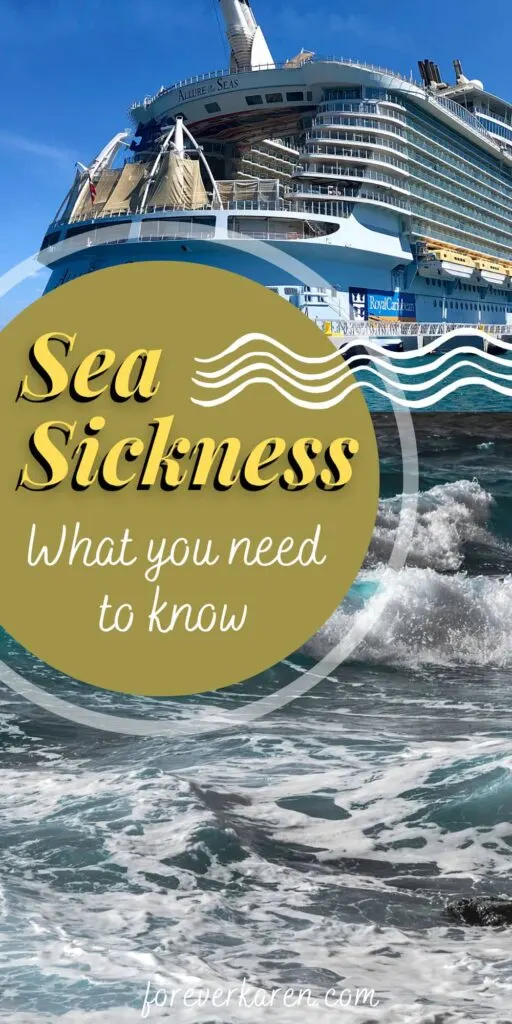

Gaynell DeLappe
Tuesday 9th of April 2019
Hello Karen, I just wanted to let you know I was here and downloaded your free book. Thank you.
Gaynell
Forever Karen
Tuesday 9th of April 2019
Hi Gaynell, Happy reading and I hope you can put the information to good use on your next cruise adventure.